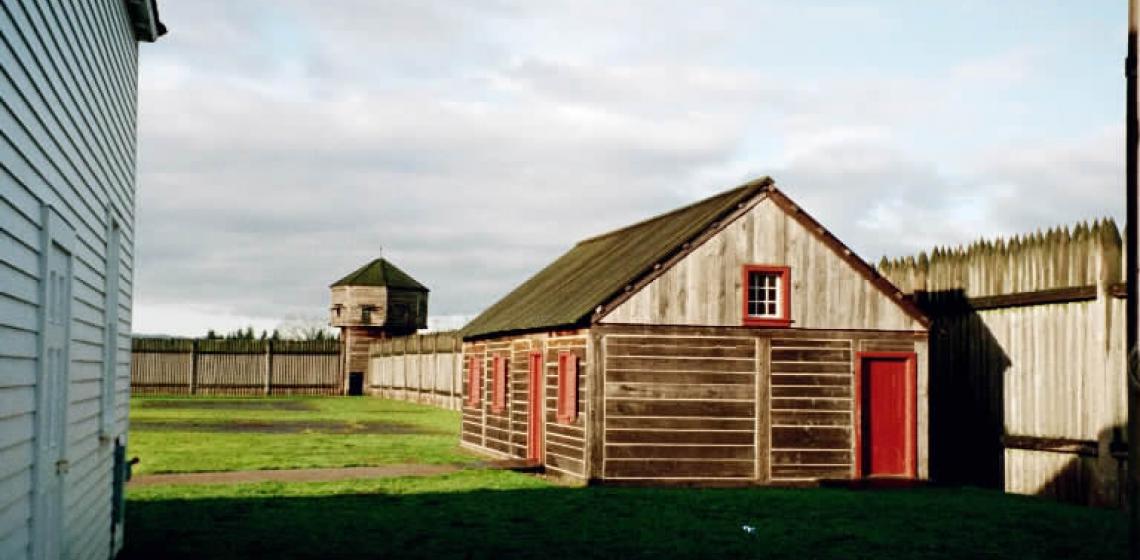
The London-based Hudson's Bay Company established Fort Vancouver in 1825 to serve as the headquarters of the Company's interior fur trade. The first Fort Vancouver was located on the bluff to the northeast of the fort's current location, where it was relocated in 1829.
The fort served as the core of the HBC's western operations, controlling the fur business from Russian Alaska to Mexican California, and from the Rocky Mountains to the Pacific Ocean. Vancouver was the principal colonial settlement in the Pacific Northwest, and a major centre of industry, trade, and law.
The Village to the west of the fort was Vancouver's first neighbourhood. The employees of the Hudson's Bay Company lived there with their families in simple one or two room cabins. The Village was incredibly diverse, a community of people whose homelands spanned half the globe.
In 1866, the fort burned to the ground. What can be visited today is a reconstruction built on the archaeological footprint of the original fort.
In 1947 the original Fort Vancouver needed to be located, so that it could be preserved by the National Park Service. At that time, the location of the fort was an open field. Reconstruction based on this archaeology began in the 1960s. Today, the fort stockade and several buildings have been reconstructed and can be explored by modern visitors.
The Garden
Historically, the garden at Fort Vancouver covered from five to eight acres.
The Company shared this abundance, providing seeds and cuttings for local Native Americans interested in agriculture, and later, American settlers to the region.
The Chief Factor's House
If one building best represented the power and dominance of the Hudson's Bay Company in the mid-nineteenth century Pacific Northwest, it was the Chief Factor's House - known by many as simply the "Big House." Here, amongst the fort's highest ranking gentlemen, news was shared, guests were entertained, policies were enacted, strategies were discussed, and agreements were made affecting lands, resources, and people from Russian Alaska to Mexican California and the Pacific Coast to the crest of the Rocky Mountains - the HBC's vast Columbia Department.
Everything about this house was designed to impress - the height, the staircase and veranda, the paint colours, the flower garden, and the cannons placed in front.
At the centre of economic, social, political activity, this building housed the top two officers at the post and their families. The building's central feature - a large hall - provided facilities for officers of the HBC and their guests to dine and enjoy holiday celebrations, religious services, weddings, and even an election under the provisional government.
Bake House
At the Bake House, Fort Vancouver's bakers made biscuits, bread, and other baked goods for hungry Hudson's Bay Company (HBC) employees and locals. A small two-story building with two impressive vaulted fire-brick ovens, the Bake House provided area residents, ocean voyagers, and traveling fur brigades with their daily dose of carbohydrates.
The Fort Vancouver Bake House must have seen a lot of demand for its baked goods because Chief Factor John McLoughlin twice asked to have the building enlarged for greater production. The reconstructed Bake House you see today is based on the final re-building from late 1844.
Carpenter Shop
Walking into the reconstructed Carpenter Shop today, you may be greeted by the shushing sound of a hand plane smoothing a board and the smell of fresh cut lumber. This experience is not much different than you may have experienced in the 1840s.
Working alongside the carpenters would have been wheelwrights, shipwrights, and coopers producing implements for the farms, ships and warehouses of the Hudson's Bay Company.
Blacksmith Shop
In an age when virtually everything needed by man can be had, ready-made from store or factory, it is somewhat difficult to imagine the need for and reliance on the blacksmith by communities of 150 to 200 hundred years ago.
To our ancestors the blacksmith combined the work of the welding shop, the service station, and the hardware store in one man. Every community had need of a good blacksmith and Fort Vancouver was no exception, employing at least four at any one time.
Text Source: Fort Vancouver website
Photo by jacki from Suburban Portland, Oregon, USA - ft. vancouver, washington, CC BY 2.0, https://commons.wikimedia.org/w/index.php?curid=2628245
